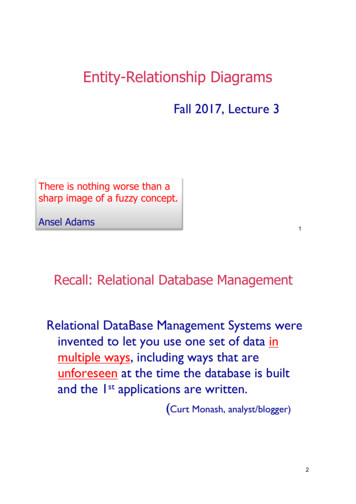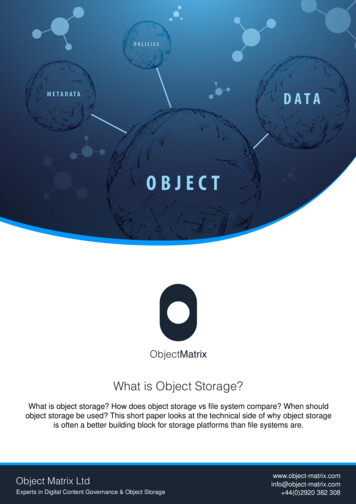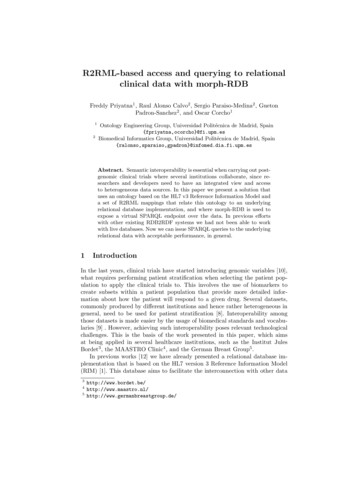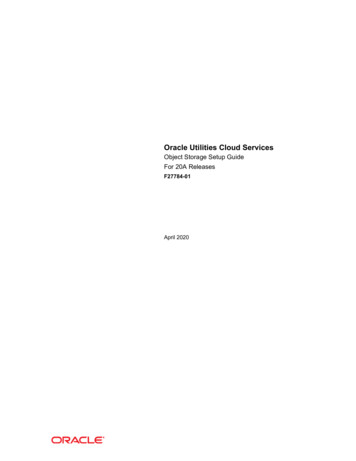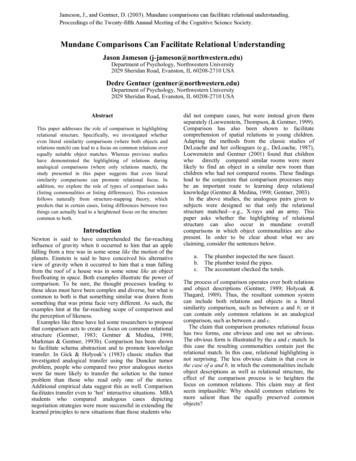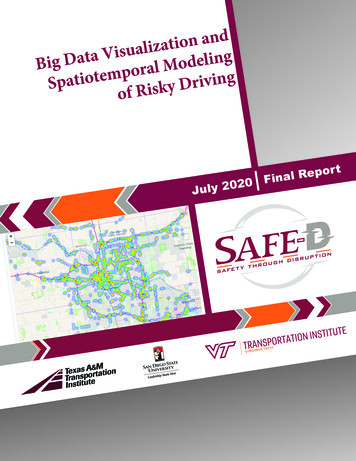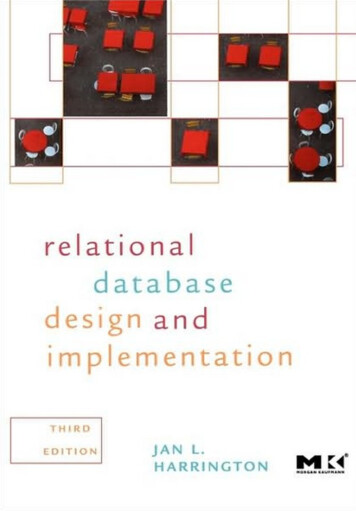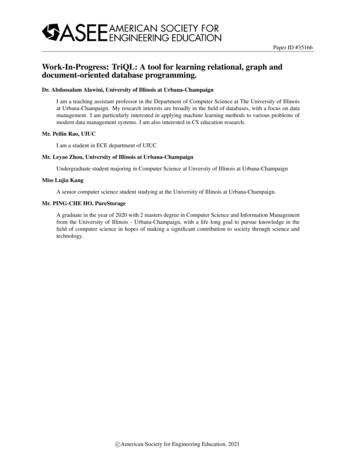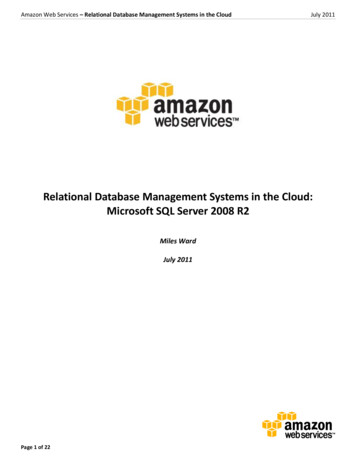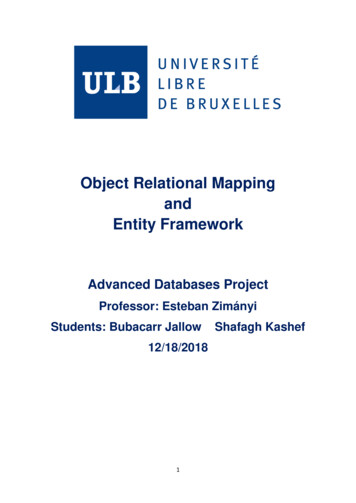
Transcription
Object Relational MappingandEntity FrameworkAdvanced Databases ProjectProfessor: Esteban ZimányiStudents: Bubacarr Jallow12/18/20181Shafagh Kashef
Contents1.Abstract . 32.Introduction . 32.1.Object-Relational Mapping . 32.2.Comparison ORM with traditional data access techniques . 42.3.Pros and Cons . 42.4.But ORM can be a pain: . 52.5.Hibernate ORM . 52.5.1.Persistence . 52.5.2.Relational Databases. 52.5.3.The Object-Relational Impedance Mismatch . 52.5.4.Granularity . 52.5.5.Subtypes (inheritance) . 62.5.6.Identity . 62.5.7.Associations . 62.5.8.Data navigation . 62.6.Why are ORMs useful? . 63.Entity Framework. 73.1.ENTITY DATA MODEL . 73.2.The Conceptual Model . 73.3.Mapping . 83.4.The Storage Model. 83.5.ENTITY FRAMEWORK CORE . 83.6.DbContext . 93.7.DbSet . 93.8.DbContextOptionsBuilder . 93.9.ModelBuilder . 93.10.Migrations . 103.11.Data Loading . 103.12.NuGet Package Manager Console . 103.13.EFCore: Code First . 103.14.EFCore: Database First . 104.IMPLEMENTATION . 114.1.Create Entity Classes and Underlying Data Sources . 114.2.Perform CRUD operation . 124.3.Making changes to the Entity Model . 145.Conclusion . 156.References: . 162
1.AbstractObject relational mapping is a framework that abstracts the communication between twodifferent programming paradigms, viz, object oriented and relational databases, which hasbeen an issue for developers since it makes their work more tedious. To tackle this problem,different technologies have been offered and the Entity Framework is Microsoft’simplementation of an ORM. Recently Microsoft is migrating towards an open source, crossplatform technology and the latest versions of the Entity Framework called the EntityFramework Core (EF Core) have been completely rewritten to render them cross-platform.Development in the EF Core follows basically two approaches, viz, the database first approachand the code first approach. The EF Core has functionalities that includes APIs, executionengines, migration toolings, etc., in order to effectively implement and ORM. In theimplementation of the code first, the application is written from scratch. Since the EF Core isnow open source, it is project to gain more popularity in the future.2.Introduction2.1.Object-Relational MappingObject-relational mapping (ORM) is a mechanism that makes it possible to address, accessand manipulate objects without having to consider how those objects relate to their datasources. ORM lets programmers maintain a consistent view of objects over time, even as thesources that deliver them, the sinks that receive them and the applications that access themchange.ORM manages the mapping details between a set of objects and underlying relationaldatabases, XML repositories or other data sources and sinks, while simultaneously hiding theoften changing details of related interfaces from developers and the code they create.ORM hides and encapsulates change in the data source itself, so that when data sources ortheir APIs change, only ORM needs to change to keep up—not the applications that use ORMto insulate themselves from this kind of effort. This capacity lets developers take advantageof new classes as they become available and also makes it easy to extend ORM-basedapplications. In many cases, ORM changes can incorporate new technology and capabilitywithout requiring changes to the code for related applications.An object-relational mapper (ORM) is a code library that automates the transfer of datastored in relational databases tables into objects that are more commonly used in applicationcode.Object-relational mapping (ORM, O/RM, and O/R mapping tool) in computer science is aprogramming technique for converting data between incompatible type systems usingobject-oriented programming languages. This creates, in effect, a "virtual object database"that can be used from within the programming language. There are both free and commercialpackages available that perform object-relational mapping, although some programmers optto construct their own ORM tools.3
In object-oriented programming, data-management tasks act on object-oriented (OO) objectsthat are almost always non-scalar values.Many popular database products such as SQL database management systems (DBMS) canonly store and manipulate scalar values such as integers and strings organized within tables.The programmer must either convert the object values into groups of simpler values forstorage in the database (and convert them back upon retrieval), or only use simple scalarvalues within the program. Object-relational mapping implements the first approach.Figure 0: Object Relational Mapping2.2.Comparison ORM with traditional data access techniquesCompared to traditional techniques of exchange between an object-oriented language and arelational database, ORM often reduces the amount of code that needs to be written.Disadvantages of ORM tools generally stem from the high level of abstraction obscuring whatis actually happening in the implementation code. Also, heavy reliance on ORM software hasbeen cited as a major factor in producing poorly designed databases.Object-Relational Mapping (ORM) is a technique that lets you query and manipulate datafrom a database using an object-oriented paradigm. When talking about ORM, most peopleare referring to a library that implements the Object-Relational Mapping technique, hencethe phrase "an ORM".An ORM library is a completely ordinary library written in your language of choice thatencapsulates the code needed to manipulate the data, so you don't use SQL anymore; youinteract directly with an object in the same language you're using.2.3.Pros and ConsUsing ORM saves a lot of time because:DRY: You write your data model in only one place, and it's easier to update, maintain, andreuse the code.It forces you to write MVC code, which, in the end, makes your code a little cleaner.You don't have to write poorly-formed SQL (most Web programmers really use it, becauseSQL is treated like a "sub" language, when in reality it's a very powerful and complex one).Sanitizing; using prepared statements or transactions are as easy as calling a method.4
Using an ORM library is more flexible because:It fits in your natural way of coding (it's your language!).It abstracts the DB system, so you can change it whenever you want.The model is weakly bound to the rest of the application, so you can change it or use itanywhere else.2.4.But ORM can be a pain:You have to learn it, and ORM libraries are not lightweight tools;You have to set it up.Performance is OK for usual queries, but a SQL master will always do better with his own SQLfor big projects.It abstracts the DB. While it's OK if you know what's happening behind the scene, it's a trapfor new programmers that can write very greedy statements, like a heavy hit in a for loop.ORM libraries:Java: Hibernate. PHP: Propel or Doctrine Python: the Django ORM orSQLAlchemyORM library in Web programming using an entire framework stack like: Symfony(PHP, using Propel or Doctrine). Django (Python, using an internal ORM).2.5.Hibernate ORM2.5.1.PersistenceHibernate ORM is concerned with helping your application to achieve persistence. Persistencemeans that we would like our application’s data to outlive the applications process. In Javaterms, we would like the state of (some of) our objects to live beyond the scope of the JVMso that the same state is available later.2.5.2.Relational DatabasesSpecifically, Hibernate ORM is concerned with data persistence as it applies to relationaldatabases (RDBMS). In the world of Object-Oriented applications, there is often a discussionabout using an object database (ODBMS) as opposed to a RDBMS.2.5.3.The Object-Relational Impedance MismatchObject-Relational Impedance Mismatch' (sometimes called the 'paradigm mismatch') is just afancy way of saying that object models and relational models do not work very well together.RDBMSs represent data in a tabular format (a spreadsheet is a good visualization for thosenot familiar with RDBMSs), whereas object-oriented languages, such as Java, represent it asan interconnected graph of objects. Loading and storing graphs of objects using a tabularrelational database exposes us to 5 mismatch problems 2.5.4.GranularitySometimes you will have an object model which has more classes than the number ofcorresponding tables in the database (we says the object model is more granular than therelational model). Take for example the notion of an Address 5
2.5.5.Subtypes (inheritance)Inheritance is a natural paradigm in object-oriented programming languages. However,RDBMSs do not define anything similar on the whole (yes some databases do have subtypesupport but it is completely non-standardized) 2.5.6.IdentityA RDBMS defines exactly one notion of 'sameness': the primary key. Java, however, definesboth object identity a b and object equality a.equals(b).2.5.7.AssociationsAssociations are represented as unidirectional references in Object Oriented languageswhereas RDBMSs use the notion of foreign keys. If you need bidirectional relationships inJava, you must define the association twice.Likewise, you cannot determine the multiplicity of a relationship by looking at the objectdomain model.2.5.8.Data navigationThe way you access data in Java is fundamentally different than the way you do it in arelational database. In Java, you navigate from one association to an other walking the objectnetwork.This is not an efficient way of retrieving data from a relational database. You typically want tominimize the number of SQL queries and thus load several entities via JOINs and select thetargeted entities before you start walking the object network.2.6.Why are ORMs useful?ORMs provide a high-level abstraction upon a relational database that allows a developer towrite Python code instead of SQL to create, read, update and delete data and schemas in theirdatabase. Developers can use the programming language they are comfortable with to workwith a database instead of writing SQL statements or stored procedures.The ability to write Python code instead of SQL can speed up web application development,especially at the beginning of a project. The potential development speed boost comes fromnot having to switch from Python code into writing declarative paradigm SQL statements.While some software developers may not mind switching back and forth between languages,it's typically easier to knock out a prototype or start a web application using a singleprogramming language.ORMs also make it theoretically possible to switch an application between various relationaldatabases. For example, a developer could use SQLite for local development and MySQL inproduction. A production application could be switched from MySQL to PostgreSQL withminimal code modifications.In practice however, it's best to use the same database for local development as is used inproduction. Otherwise unexpected errors could hit in production that were not seen in a local6
development environment. Also, it's rare that a project would switch from one database inproduction to another one unless there was a pressing reason.3.Entity FrameworkThe entity framework is Microsoft’s implementation of an ORM. It enables .NET developersto work with relational data using domain-specific objects, i.e., developers are able to withdata within a conceptual model. It is aimed at increasing the developer’s productivity byreducing the redundant task of persisting the data used in the applications. The figure belowshows the overall architecture of the entity frameFigure 1: Entity Framework Architecture (EntityFrameworkTutorial.net, 2016)EDM (Entity Data Model): Model classes, relationships, mappings, database models etc.LINQ to Entities: Query language for writing queries against the object model.Entity SQL: Also a query languageObject Service: For materialization, i.e., conversion of RDBMS data into object instances.Entity Client Data Provider: Translating LINQ and Entity SQL to DBMS SQL.ADO.Net Data Provider: Communication with databases using standard ADO.Net.(EntityFrameworkTutorial.net, 2016)3.1.ENTITY DATA MODELThe EDM is one of the main components of the entity framework and . “It is a set of conceptsthat describe the structure of data, regardless of its stored form.” (Microsoft, 2017). The EDMis made up of three major parts:3.2.The Conceptual ModelThis conceptual model constitutes the real entity model against which we write our queries.This is where we define our entity classes including relationships between entities, properties.It gives us a high-level view of the type of database we will generate.7
3.3.MappingThis provides a mapping between the conceptual model and storage model.3.4.The Storage ModelThe Storage Model gives a schematic representation of the backend data store.The entity model mainly uses three concepts to describe data structure: Entity TypeEntity types are used to describe the structure of the data in the Entity Data Model. Association TypeAssociation types are used for describing relationships such as the referential constraints thatwill exist in our database. Property TypeThe property type gives meaning and structure to the entities by defining thecharacteristics or composition of that entity, e.g., a Customer entity, has CustomerId,CustomerName, etc as properties. These property type can have both primitive typesand complex types.3.5.ENTITY FRAMEWORK COREIn this project, we consider a version of the entity framework called the Entity Framework(Core EF Core). EF Core is lightweight, extensible and cross-platform and a complete re-writeof the original entity framework.The following are basically, the core functionalities of the entity framework core: An API for defining the Entity ModelAn API for querying the Entity ModelAn Execution Engine that figures out how to convert a LINQ query into SQL commandand executing it.Reverse Engineering a database in order to create a baseline entity model based onan existing database schema using.Migrations tooling that takes a snapshot of the existing model state and uses it togenerate the code that needs to be applied to the database in order to update it,bringing it into sync with the current state of the entity model.Database Generation Tooling that takes the model and Migration classes andgenerates or updates the database schema.8
3.6.DbContextThe DbContext is the most fundamental core of the EFCore. It is the class that “knows” howto execute a query on a data source. Each DbContext is associated with a data source. Thefollowing are some of the main functions of the DbContext: Provide connection to the database and keeping that dataQuerying the model and converting the queries into T-Sql. Queries run against thedatabase directly and do not contain any pending changes.Help in the process of retrieving the results and putting them into instances of themodel and holding on to them.Keep track of changes made in the object instances so as to enable it to know whatto update when the method SaveChanges() is invoked.The afore mentioned are accomplished through the use of special classes and methods withinthe DbContext:3.7.DbSetThis is used to represent a collection for a given entity within the model and it is actually thegateway to database operation against the entity. They are mapped by default to databasetable. (learnentityframeworkcore.com, 2017)3.8.DbContextOptionsBuilderContains a series of extension methods such UseSqlServer() that helps in the configuration ofa DbContextOptions such that we are able to connect to and use SqlServer in this case. SinceEFCore is platform independent, you can connect to different databases aside SqlServer. TheDbContextOptions contains a host of settings for individual database engines with eachengine having its own list of settings.3.9.ModelBuilderBased on the entity classes definitions while adhering to conventions, the EFCore is able toconstruct a model for the database and apply certain configurations. These configurationscan however, be overwritten or supplemented through data annotations or Fluent API. TheFluent API is accessed by overriding the OnModelCreating method in the derived context anduses the ModelBuilder API to configure the model. This is the most powerful method forconfiguring the model and allows the configuration to be specified without modifying theentity classes. (Microsoft, 2017).9
3.10.MigrationsMigration allows us to continue to change the entity model throughout the applicationdevelopment lifecycle. It contains two methods, name the Up and Down methods. The Upmethod updates the database to the latest version of the entity model whilst the Downmethod rolls back changes from the current migration and restores the database to a previousmigration.3.11.Data LoadingThere are three ways data can be loaded into your application from the database. Lazyloading, which is often the default, involves loading the main entity referenced in the query.It does not load the related entities included in your query. Lazy loading can be turned on oroff. If the lazy loading is turned off, we can explicitly load the entities we require by using theExplicit loading. We use the Load method on the related entity’s entry.The third type of loading is used to load the related entities that are part of a query after themain entity of the query has been loaded. This is called Eager Loading and involves of the useof Include (and ThenInclude) methods. This fetches a huge chunk of data in one queryoperation as it has to return all related data.3.12.NuGet Package Manager ConsoleThis command line interface is extensively used to run commands that help us setup or installour EFCore, add migrations, update databases and so forth.3.13.EFCore: Code FirstIn this approach, all the coding is done in the application platform and the entity classes arebuilt from scratch. The entity classes are then used to generate the database. This approachis used in the implementation for our project.3.14.EFCore: Database FirstReverse engineering techniques are applied in this approach to generate entity classes fromalready existing databases. The process involves running the following command in the NuGetPackage Manager and specifying the database connection string and optionally the folder andcontext.Scaffold-DbContext “ connection-string ” Microsoft.EntityFrameworkcore.SqlServer OutputDir Folder -Context context name 10
4.IMPLEMENTATIONWe will be using the code first approach to illustrate the basic features and processes involvedin creating and adding an EFCore into your project or application. The following workflow isassumed:1. Install EFCore and Tooling2. Create Entity Model and underlying data source3. Perform CRUD operationInstalling EFCore and ToolingThe following three commands are used to add the EF core to our application: Install-Package Microsoft.EntityFrameWorkcore.SqlServer Install-Package Microsoft.EntityFrameWorkcore.Tools -Pre Install-Package Create Entity Classes and Underlying Data SourcesIn the code first based approach, we create our entity classes the same we way write ournormal plain old CLR object (POCO) classes as follows:Figure 2The class and class properties will represent the table and columns of our databaserespectively, that will be generated. By following certain conventions, the EF coreautomatically identifies constraints like primary keys and generate them. Foreign keyrelationships are also established by creating instance of the class e.g., Customer inside theOrder class. In the same vein, a one to many relationship is also established in a similarmanner but declaring it as a List type.In order for the EF Core to generate our database appropriate, we must first establish aconnection to our database using the DbContextOptionsBuilder:11
Figure 3Then we use the DbSets to indicate to the EF Core how to set up our tables and naming them:Figure 4In this example, these three tables are generated when we migrate changes. In addition, afourth table, the OrderItems table, is also generated in our case without creating a DbSet forit. This is because an Order contains a list of OrderItems and indeed we declared a list ofOrderItems in the Order class. Therefore we optionally omit it and the EF Core automaticallydetects the parent child relationship (one to many).4.2.Perform CRUD operationTo perform a create operation, i.e., inserting into our database, we will need to open aconnection to our database by creating an instance of our Context using the following syntax,which is one way of doing it:Figure 5We create a using method (part of the EF Core) and pass an instance of our Context. We thencreate our objects and add them to our context using the Add() method, then SaveChanges();12
Figure 6Once the using method finishes execution and the program quits out of it, the databaseconnection is automatically closed. The Read, Update and Delete operations follow similarprocedure in opening and closing connections to the database.To read from the database, we create an object to hold our data that will be retrieved fromthe database and using a for each loop to iterate through and access the individual rows.Figure 7If a join is involved, we do an eager loading to load the other tables using the Include().Updating and Deleting involves retrieving the particular row, and updating and deleting themrespectively13
Figure 84.3.Making changes to the Entity ModelWe use Data Annotations and the Fluent API to effect changes or make further configurationssuch enforcing constraints in our entity classes. Data Annotations are applied directly to theclasses or class properties we intend to configure. The Data annotations, however, is just asubset of the fluent API and a lot more configuration can be done with the fluent withouthaving to modifying the entity classes directly. The Fluent API is accessed by overriding theOnModelCreating method derived from the DbContext.Figure 9Figure 1014
5.ConclusionMicrosoft is making a number of changes to most of their frameworks to render them opensource and cross-platform. The Entity framework is one of those frameworks in the form ofthe entity framework core which has been completely rewritten from scratch but maintainsmost of the “relevant” functionalities from the most recent release before the entityframework core (i.e., EF 6). In addition, the EF Core also has other functionalities making itsimpler and easier to use. Being open source and cross-platform, the EF core and other suchframeworks from Microsoft are projected to gain more popularity and prominence in thefuture. The easy syntax and the numerous abstractions being added to this new breed of theentity framework, i.e., the EF Core, developers are now sure to concentrate more on theimportant task of the business logic and make production faster. The performance of the EFCore has been proven to be relatively solid in most case but still needs to cope with largerapplications, one of the main drawbacks of EF Core.15
6.References: EntityFrameworkTutorial.net. (2016). Entity Framework Architecture. x learnentityframeworkcore.com. (2017). The Entity Framework Core DbSet - fromhttp://www.learnentityframeworkcore.com/dbset Microsoft. (2017). Entity Data Model Microsoft Docs. Retrieved December 16, 2017,from data/adonet/entity-datamodel https://en.wikipedia.org/wiki/Object-relational mapping "What is Object/Relational Mapping?". Hibernate Overview. JBOSS Hibernate.Retrieved 19 April 2011. Douglas Barry, Torsten Stanienda, "Solving the Java Object Storage Problem,"Computer, vol. 31, no. 11, pp. 33-40, Nov. 199816
3.Entity Framework The entity framework is Microsoft's implementation of an ORM. It enables .NET developers to work with relational data using domain-specific objects, i.e., developers are able to with data within a conceptual model. It is aimed at increasing the developer's productivity by

